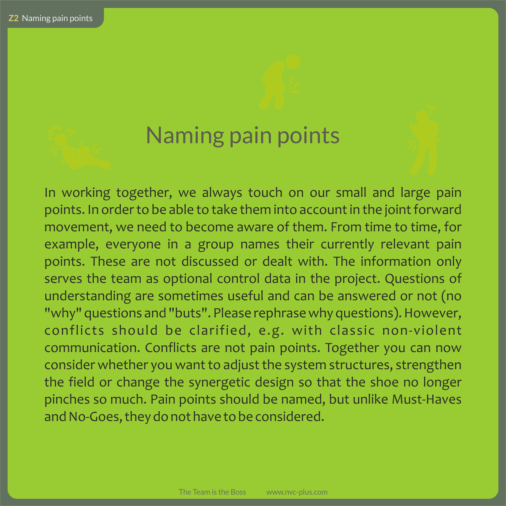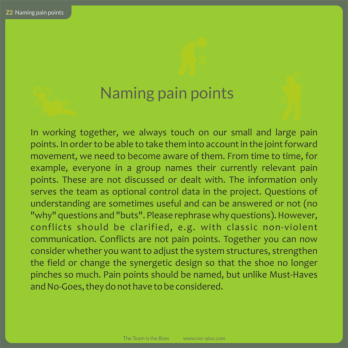
Pain Points
How to turn your team
into the boss


- The 6 Hurdles
- The Elements
- What are the Elements
- Culture Stage Model
- Gut, Head or Herart Process
- Culture Change
- List of Feelings and Needs
- Emergency Emo-Step
- Four Step Circle
- NVC Magic Circle
- Utopia Magic Circle
- Utopia and Vision
- No-Goes and Must-Haves
- Pain Points
- Consensus
- Requirement Lists
- NVC-plus Strategy
- NVC-plus Matrix
- Discourse
- Card Set
- Download-Tool-Depot
- FAQs
- Events
- Media

6 Hurdles to Self-Organization
Chapter 20 - Pain Points



Home / hurdle 5: toolbox / pain points

Successful
cooperation
is
both
a
path
and
a
goal.
Good
methods
and
tools
make
it
much
easier
for
a
team
to
organize
itself.
Encourage
your
team
to
take
the
first
steps
in
this
direction
and
experience the difference.
NVC-plus
gives
you
the
opportunity
to
take
a
stand
on
an
unpleasant
situation
by
naming
the
pain
points
you
are
experiencing.
A
pain
point
is
not
a
No-Go,
but
it
shows
that
the
team
is
navigating
a
person's
boundaries.
If
this
is
clearly
stated
by
the
person,
it
gives
the
others
the
opportunity
to
take
this
information
into
account
for
the
way
forward.
However,
they
don't
necessarily
have
to,
because otherwise it would be a No-Go.
Some
people
may
need
support
or
a
bit
of
a
push
to
get
the
necessary
clarity
in
the
message.
This
is
also
clearly
a
pain
point,
as
it
is
not
a
common
objection.
The
pain
point
is
where
the
factual issues and personal reactions come together.
Additional card Z2
NVC-plus
has
several
tool
cards
and
a
few
additional
cards.
The
additional
card
Z2
is
the
card
that
explains
the
pain
points.
The
No-Gos
and
Must-Haves
and
No-Gos,
on
the
other
hand,
can
be
found
on tool card T2.1.
The
good
thing
about
using
pain
points
to
take
a
stand
is
that
you
take
responsibility
for
an
unpleasant
situation
and
don't
project
it
onto
others
or
blame
it
on
the
circumstances.
So
you
don't
say
"You
didn't
turn
off
the
light
in
the
room
again.
You
never
think
about
the
environment.
That's
not
possible".
This
sentence
includes
the
other
person,
the
room
and
the
environment.
Only
you
yourself
have
not
found
a
place
in
it.
That's
why
the
sentence
appears
to
be
a
dominant
claim.
If
you
say
instead:
"You've
left
the
light
on
in
the
chamber
again.
That's
a
pain
point
of
mine.
It
hurts
me
because
I
think
about
the
environment",
then
you
have
found
a
place
for
yourself
in
the
sentence.
The
Argentinian
coach
Fred
Koffman
spoke
of
the
position
of
nowhere,
from
which
the
first
version
of
the
statement
was
spoken.
If
you
refuse
to
take
your
own
stance
while
at
the
same
time
being
highly
emotional,
it
is
difficult
to
communicate
with
each
other
afterwards.
On
the
other
hand,
at
NVC-plus
we
want
to
avoid
long
discussions,
as
this
often
achieves
far
too
little
in
relation
to
the
result.
One
sentence
is
enough
to
give
the
other
person
the
information
they
need
to
avoid
a
pitfall.
If
they
don't
want
to
do
that,
you
can
put
up
with it, or tackle it at the right time with classic NVC (non-violent communication).

The cards are described in more detail in the book, as
well as in the Power Point presentation available in the
download tool depot.

Every team, start-up, or company must overcome these six hurdles if it wants to organize itself
collegially in order to successfully manage projects from within the community.
Pain Points
The cards are described in more detail
in the book, as well as in the Power
Point presentation available in the
download tool depot.


b) Pain Points





Chapter 20 - Pain Points


- The 6 Hurdles
- The Elements
- What are the Elements
- Culture Stage Model
- Gut, Head or Herart Process
- Culture Change
- List of Feelings and Needs
- Requirement Lists
- NVC Magic Circle
- Utopia Magic Circle
- Emergency Emo-Step
- Four Step Circle
- Utopia and Vision
- No-Goes and Must-Haves
- Pain Points
- Consensus
- NVC-plus Strategy
- NVC-plus Matrix
- Discourse
- Card Set
- Download-Tool-Depot
- FAQs
- Events
- Media
Successful
cooperation
is
both
a
path
and
a
goal.
Good
methods
and
tools
make
it
much
easier
for
a
team
to
organize
itself.
Encourage
your
team
to
take
the
first
steps
in
this
direction
and
experience
the
difference.
NVC-plus
gives
you
the
opportunity
to
take
a
stand
on
an
unpleasant
situation
by
naming
the
pain
points
you
are
experiencing.
A
pain
point
is
not
a
No-Go,
but
it
shows
that
the
team
is
navigating
a
person's
boundaries.
If
this
is
clearly
stated
by
the
person,
it
gives
the
others
the
opportunity
to
take
this
information
into
account
for
the
way
forward.
However,
they
don't
necessarily
have
to,
because
otherwise
it
would be a No-Go.
Some
people
may
need
support
or
a
bit
of
a
push
to
get
the
necessary
clarity
in
the
message.
This
is
also
clearly
a
pain
point,
as
it
is
not
a
common
objection.
The
pain
point
is
where
the
factual
issues
and
personal
reactions
come together.
Additional card Z2
NVC-plus
has
several
tool
cards
and
a
few
additional
cards.
The
additional
card
Z2
is
the
card
that
explains
the
pain
points.
The
No-
Gos
and
Must-Haves
and
No-Gos,
on
the
other hand, can be found on tool card T2.1.
The
good
thing
about
using
pain
points
to
take
a
stand
is
that
you
take
responsibility
for
an
unpleasant
situation
and
don't
project
it
onto
others
or
blame
it
on
the
circumstances.
So
you
don't
say
"You
didn't
turn
off
the
light
in
the
room
again.
You
never
think
about
the
environment.
That's
not
possible".
This
sentence
includes
the
other
person,
the
room
and
the
environment.
Only
you
yourself
have
not
found
a
place
in
it.
That's
why
the
sentence
appears
to
be
a
dominant
claim.
If
you
say
instead:
"You've
left
the
light
on
in
the
chamber
again.
That's
a
pain
point
of
mine.
It
hurts
me
because
I
think
about
the
environment",
then
you
have
found
a
place
for
yourself
in
the
sentence.
The
Argentinian
coach
Fred
Koffman
spoke
of
the
position
of
nowhere,
from
which
the
first
version
of
the
statement
was
spoken.
If
you
refuse
to
take
your
own
stance
while
at
the
same
time
being
highly
emotional,
it
is
difficult
to
communicate
with
each
other
afterwards.
On
the
other
hand,
at
NVC-plus
we
want
to
avoid
long
discussions,
as
this
often
achieves
far
too
little
in
relation
to
the
result.
One
sentence
is
enough
to
give
the
other
person
the
information
they
need
to
avoid
a
pitfall.
If
they
don't
want
to
do
that,
you
can
put
up
with
it,
or
tackle
it
at
the
right
time
with
classic NVC (non-violent communication).

Pain Points











































